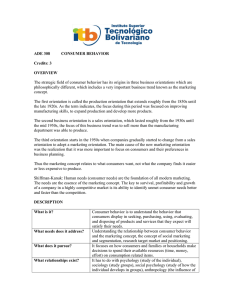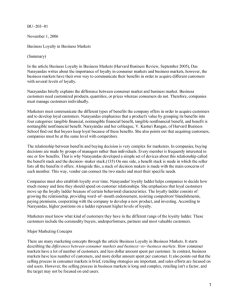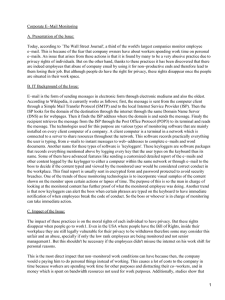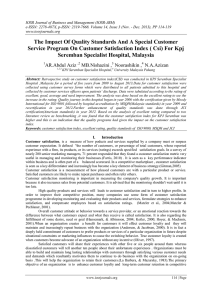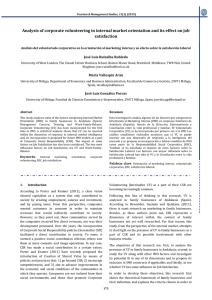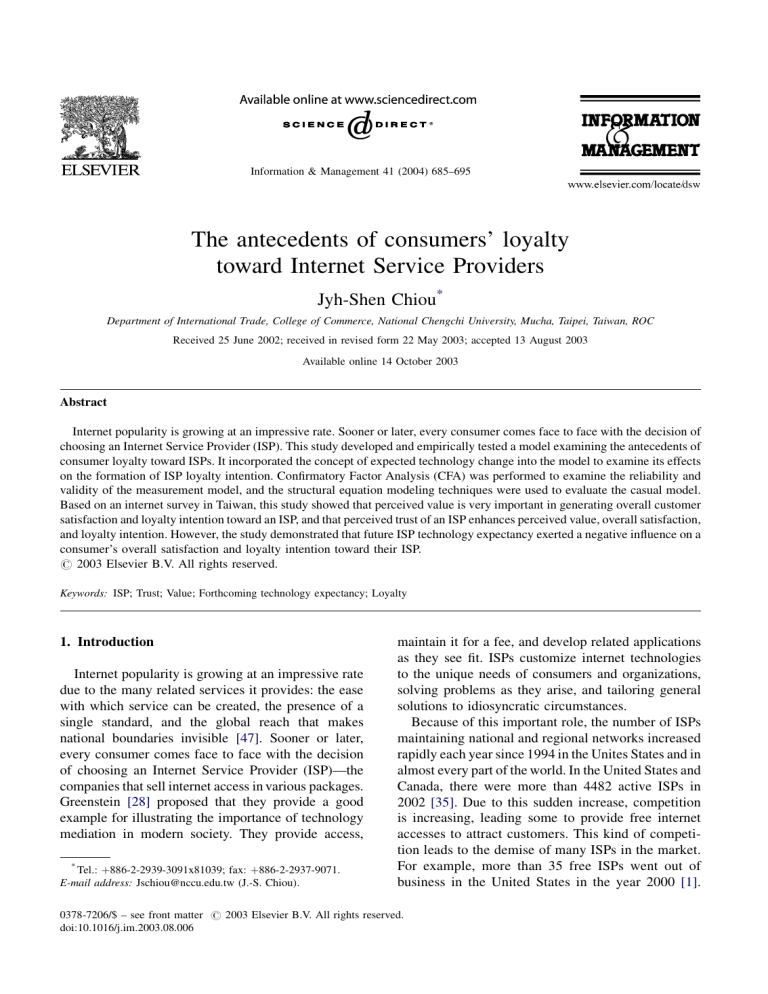
Information & Management 41 (2004) 685–695 The antecedents of consumers’ loyalty toward Internet Service Providers Jyh-Shen Chiou* Department of International Trade, College of Commerce, National Chengchi University, Mucha, Taipei, Taiwan, ROC Received 25 June 2002; received in revised form 22 May 2003; accepted 13 August 2003 Available online 14 October 2003 Abstract Internet popularity is growing at an impressive rate. Sooner or later, every consumer comes face to face with the decision of choosing an Internet Service Provider (ISP). This study developed and empirically tested a model examining the antecedents of consumer loyalty toward ISPs. It incorporated the concept of expected technology change into the model to examine its effects on the formation of ISP loyalty intention. Confirmatory Factor Analysis (CFA) was performed to examine the reliability and validity of the measurement model, and the structural equation modeling techniques were used to evaluate the casual model. Based on an internet survey in Taiwan, this study showed that perceived value is very important in generating overall customer satisfaction and loyalty intention toward an ISP, and that perceived trust of an ISP enhances perceived value, overall satisfaction, and loyalty intention. However, the study demonstrated that future ISP technology expectancy exerted a negative influence on a consumer’s overall satisfaction and loyalty intention toward their ISP. # 2003 Elsevier B.V. All rights reserved. Keywords: ISP; Trust; Value; Forthcoming technology expectancy; Loyalty 1. Introduction Internet popularity is growing at an impressive rate due to the many related services it provides: the ease with which service can be created, the presence of a single standard, and the global reach that makes national boundaries invisible [47]. Sooner or later, every consumer comes face to face with the decision of choosing an Internet Service Provider (ISP)—the companies that sell internet access in various packages. Greenstein [28] proposed that they provide a good example for illustrating the importance of technology mediation in modern society. They provide access, * Tel.: þ886-2-2939-3091x81039; fax: þ886-2-2937-9071. E-mail address: Jschiou@nccu.edu.tw (J.-S. Chiou). maintain it for a fee, and develop related applications as they see fit. ISPs customize internet technologies to the unique needs of consumers and organizations, solving problems as they arise, and tailoring general solutions to idiosyncratic circumstances. Because of this important role, the number of ISPs maintaining national and regional networks increased rapidly each year since 1994 in the Unites States and in almost every part of the world. In the United States and Canada, there were more than 4482 active ISPs in 2002 [35]. Due to this sudden increase, competition is increasing, leading some to provide free internet accesses to attract customers. This kind of competition leads to the demise of many ISPs in the market. For example, more than 35 free ISPs went out of business in the United States in the year 2000 [1]. 0378-7206/$ – see front matter # 2003 Elsevier B.V. All rights reserved. doi:10.1016/j.im.2003.08.006 686 J.-S. Chiou / Information & Management 41 (2004) 685–695 to the creation and maintenance of effective customer retention programs [10], especially for the ISP industry. ISPs have to devise competitive program to retain their customers. Therefore, it is important to examine the factors that influence consumer loyalty intentions, so that struggling companies might design more effective customer retention strategies. First, we developed and empirically tested a model for examining the antecedents of consumer loyalty intentions toward an ISP. Second, we incorporated the concept of expected forthcoming innovations into the model and examined the effect on formation of loyalty intention. If consumers expect a future technology improvement, their expectations will impact their assessment of existing services [67]. In addition, according to a survey by messaging consultancy, Outade.com, one third of UK ISPs will go out of business over the next few years [17]. Therefore, it is important to understand the driving forces of consumer loyalty, because strong loyalty can help an ISP survive fierce competition. Satisfaction has historically been identified as the major driver for customer brand or company loyalty, making high customer satisfaction a key goal. Although this proposition is not totally disregarded by marketers, it is challenge by several studies claiming that more than half of the satisfied customers will defect eventually [39]. Customer satisfaction may be important, but it cannot explain all the variance of customer loyalty. It may even become independent of satisfaction, so that temporary reversals in satisfaction may not influence long-term loyalty intention. Since gaining new customers in the competitive market is becoming difficult and the profit gained from a loyal customer grows within the duration of the business relationship, companies are shifting their marketing focus from pure satisfaction generation to loyalty cultivation [58]. Companies believe that customer loyalty is the key to long-term profitability, both in the business-to-business and business-to-consumer exchange relationship [57]. They are more committed Future ISP Expectancy 2. Conceptual framework and hypotheses Fig. 1 presents a model of a consumer’s loyalty formation; attributive service satisfaction, perceived trust toward the ISP, and future ISP expectancy are modeled as exogenous variables, while construct regarding perceived value and overall satisfaction are modeled as the mediators between exogenous variables and consumer loyalty intention toward H9 (-) H8(-) H3(+) Attributive Service Satisfaction H1(+) Perceived Value H2 (+) Overall Satisfaction H5(+) H4(+) Perceived Trust Fig. 1. Proposed framework. H6 (+) H7 (+) Loyalty Intention J.-S. Chiou / Information & Management 41 (2004) 685–695 the ISP. The framework is based on Bagozzi’s [4] appraisal ! emotional response ! coping framework. In the research model, there are two types of satisfaction. The first, attributive service satisfaction, refers to a customer’s cognitive satisfaction regarding individual attributes and services of the providers [26,40]. Westbrook proposed that attributive service satisfaction is an accumulation of separate satisfactions with salespeople, store environment, products, and other factors [70]. ISPs provide different kinds of services, such as internet access, email accounts, and technical support. Consumers will form their attributive service satisfaction toward an ISP based on their cumulative satisfaction with the individual services they receive. The second type, overall satisfaction, stems from a customer’s perception of the transaction experience as a whole [53]. Overall satisfaction is defined as ‘‘pleasurable fulfillment’’ and an affective response in Oliver’s loyalty framework [50]. Therefore, overall satisfaction of an ISP is defined as an affective construct, whereas attributive service satisfaction is defined as a cognitive construct. 2.1. Attributive satisfaction, perceived value, overall satisfaction and loyalty intention As defined by Zeithaml et al. [71], perceived value is a consumers’ overall assessment of the utility of a product or service based on perceptions of what is received and what is given. It is the trade-off between received benefit and cost. Based on the means-end chain, value is assumed to be a higher-level abstraction. It is more personal and individualistic than attributive service satisfaction. Similar to the studies regarding the positive effect of service quality on perceived value [62,68], favorable attributive service satisfaction of an ISP can enhance a consumer’s perception of what is received. In other words, customers who received better ISP services will have more positive perception towards it. These positive perceptions in turn improve the perceived value toward the ISP. Thus: H1. Attributive satisfaction with an ISP’s service will positively affect a consumers’ perceived value of the ISP. 687 Past research has shown that perceived value is an important antecedent for overall satisfaction and future purchase intention. For example, in efforts to conceptualize the effects of quality, satisfaction, and value on consumer behavioral intentions, Cronin et al. [18] found that perceived value had direct and positive impacts on overall satisfaction and behavioral intention. Similarly, Patterson and Spreng [52] found that perceived value directly affects overall satisfaction. As emphasized by Sirdeshmukh et al. [61], value, a superordinate consumer goal, regulates consumer actions at the level of loyalty intention. Consumers are expected to regulate their actions towards achievement of this goal; they will indicate loyalty intentions toward a service provider as long as the transaction provides superior value. Similarly, Bolton and Drew [9] found that value is an important determinant of consumers’ loyalty intention toward telephone services. Chang and Wildt [13] also found that value drives loyalty in the context of personal computers and apartments. Therefore, it is believed that perceived value toward an ISP will directly affects overall satisfaction toward the ISP. H2. Perceived value of an ISP’s service will positively affect consumers’ overall satisfaction with the ISP. H3. Perceived value of an ISP’s service will positively affect consumers’ loyalty intention toward the ISP. 2.2. Perceived trust, overall satisfaction, and loyalty intention Rao [56] proposed that system integrity is one of the most important factors for an ISP. It must have integrity against breaches of security and failure of hardware and software. Trustworthiness is also an important factor for E-commerce success [22,42,66,69]. As claimed by Kirmani and Rao [41], trust-related issues cannot be fully resolved after purchase when violations of quality claims cannot be unambiguously recognized after usage. Internetrelated business involves many ambiguous aspects of services. Thus, the management of customer trust is especially important. Similar to Morgan and Hunt [45], our study proposed that trust is an important factor in consumer 688 J.-S. Chiou / Information & Management 41 (2004) 685–695 outcome evaluation; i.e. consumers’ perceived trust for an ISP influences their overall satisfaction with it. The framework proposed by Singh and Sirdeshmukh [60] supports this assertion by distinguishing between trust before initiation of an exchange (pre-trust) and after an exchange (post-trust). Based on social exchange theories, they propose that customers’ pre-trust will have direct influence on their post-purchase satisfaction. Therefore, it can be argued that accumulated trust perceptions will affect accumulated overall satisfaction. Furthermore, Gwinner et al. [29] also found that customers in long-term relationships with service firms experienced three primary benefits: confidence, social, and special treatment benefits. Among the three, confidence (which is similar to trust for the ISP in our study) was found to be the most important across several categories of services. Confidence benefits include a sense of reduced anxiety, faith in the provider, reduced perceptions of anxiety and risk, and knowing what to expect. Thus: Finally, research in customer satisfaction found that satisfied customers are more likely to purchase the same product/service repeatedly, to resist competitive offers from competitors, and to generate positive word of mouth [3,8,11,19,72]. Research in the American Customer Satisfaction Index provides additional empirical support for positive customer loyalty responses as the major consequence of customer satisfaction [24]. Research in the ISP industry also found similar results. Therefore, it is reasonable to predict that consumers who are satisfied with an ISP have a higher loyalty intention toward an ISP. H4. Customers’ trust in an ISP provider will positively affect their overall satisfaction. Product performance can affect customers’ satisfaction and loyalty to a high degree [6,12]. However, if consumers expect a future technology improvement, this expectation will impact their assessment of existing and future technologies. This is particularly critical when products with intermediate levels of technology are introduced while the market waits for future technology introduction. Consumers have learned to anticipate improvements in technology and reduction in prices for these kinds of products. As argued by Furedi [23] and Glassner [27], avoiding risk has become a dominant cultural theme, and technology is equated with risk. Therefore, it is very important to incorporate consumers’ future expectations in modeling their satisfaction and loyalty intentions. As proposed by Lemon et al. [43], consumers not only consider current and past evaluations of the supplier’s performance (e.g. service satisfaction, perceived value, overall satisfaction) but also incorporate future considerations of what the service will be. The satisfaction formation model can be enhanced by incorporating these future considerations. Similarly, Holak et al. find that when considering the purchase of high technology products, consumers incorporate their expectations of the timing of the next-generation technology into their purchase decision [32]. Following Chaudhuri and Holbrook [14], it is proposed that commitment in the form of loyalty intention is a result of trust. Trust seems implicit in customer intention [65]. Trust is the perception of confidence in the exchange partners’reliability and integrity, and it is a necessary ingredient for long-term orientation because it shifts the focus to future conditions [21,25]. Thus: H5. Customers’ trust in the ISP will positively affect their loyalty intention. Trust not only affects loyalty intention directly, it also affects it indirectly through perceived value. Consumers are thought to consummate exchanges with providers that offer maximum value. Perceived trust of the service provider can create value by providing relational benefits derived from interacting with a service provider and reducing the exchange uncertainty. Therefore, if customers have higher perceived trust toward an ISP, they will have higher perceived value toward using it. Thus: H6. Perceived trust of an ISP will positively affect consumers’ perceived values toward the ISP. H7. Consumers’ overall satisfaction with an ISP will positively affect their loyalty intention toward the ISP. 2.3. Effect of expected technology change on overall satisfaction and loyalty intention J.-S. Chiou / Information & Management 41 (2004) 685–695 Providers have not offered a standardized menu of services, which is indicative of the lack of consensus about the optimal business model. Firms have to face technical, commercial, and structural challenges that force them to adapt their operation and business processes. Therefore, consumers are forced to modify facilities (software and hardware) frequently, making consumers’ future considerations an important part of models dealing with this market. Chen et al. [15] found that compatibility of an innovation with existing services is very important for its adoption. Therefore, when consumers feel that current service will not be compatible with the future technology, they will have lower loyalty intention toward their service. It is therefore proposed that if consumers expect that a new ISP service will provide better technology and services in the near future, they will not have high satisfaction and strong loyalty intention toward their current ISP. On the other hand, if consumers expect that their ISP services are going to be the best available in the market for a long time, they will have strong satisfaction and loyalty intention toward it. Therefore: H8. High future technology expectancy for ISPs will negatively affect customer overall satisfaction toward their current ISPs. H9. High future technology expectancy for ISPs will negatively affect customer loyalty intention toward their current ISPs. 3. Method 3.1. Study object and sample Over the past 30 years, the Taiwanese economy evolved through three stages: from underdeveloped, to developing, to being a leading producer of high technology goods. Taiwanese IT firms have specialized as the electronic world’s OEM partners and Taiwan has grown to be the largest OEM country for personal computing products. In 2000, its production value of IT hardware exceeded 48 billion US dollars, placing it at number four among major IT producing countries in the world [36]. Driven by encouraging state policies 689 and advances in Internet access technology, the ISP industry has shown impressive development over the past five years, with more than 50 ISPs competing for this emerging market. In 2001, there were around 8 million internet users, which represents 35% penetration rate in the whole island. Among these users about 62% access internet through commercial ISPs, while the rest get their internet access from school’s or company’s ISPs [34]. Although this internet penetration rate is not as high as that of the United States, this figure puts Taiwan as one of the most internet connected societies in Asia Pacific. Since this study explored the loyalty of household users toward commercial ISPs, only household users of commercial ISPs were included. To effectively reach these users of ISPs in Taiwan, an internet-based survey was employed to gather information (see [54] for an explanation of benefits of an internet-based survey). With the assistance of a marketing research firm in Taiwan, a total of 10,000 surveys were emailed randomly to individuals within the company’s database. Before the formal study, a pretest involved exploratory interviews with users of ISPs was conducted to make sure the questionnaire was relevant and clear to the respondents. Because we did not know whether the respondents used a commercial ISP or not in advance, this sampling frame included those who use other portals to access the internet. One question on the first page was used to screen qualified responses. For those who used a company or school portal, only a few internet and background related questions were administrated. Once the questionnaire was completed, the responses were automatically sent to the database. The respondents were guaranteed that all answers were anonymous. A reminder letter was emailed approximately one week after the questionnaire. The return questionnaires were initially screened for usability and reliability. Overall, 408 completed responses were received. Among them, 199 used company or school portals. Therefore, only 209 responses were usable for further analyses. The response rate is slightly lower than ordinary mail surveys in Taiwan (averaging 5–10%). However, considering the length of the questionnaire, the response rate is acceptable. More importantly, our sampling method was successful in soliciting respondents with varied personal characteristics, and 690 J.-S. Chiou / Information & Management 41 (2004) 685–695 the background proportion was consistent with surveys of typical internet users in Taiwan. Respondents were young and well educated. They varied in sex (female, 43%; male, 57%), age (<20 years of age, 43%; 21–25 years of age, 42%; 26–30 years of age, 9%, >30 years of age, 5%), and education (high school diploma, 5%; some college, 10%; university or higher 85%). 3.2. Measure development Self-administered questionnaires were used for all measures. Where possible, established measures were used to measure the latent constructs. The measures tapped consumers’ perceptions of their relationship with the ISP that they used most frequently. All measures used are shown in Table 1. A pre-test on 20 ISP users was conducted to solicit the most important attributive services of their ISPs. The results showed that connection speed, email services, online service assistance, and technical support and consulting were most important to consumers. Attributive service satisfaction was operationalized by asking ‘‘Please rate your satisfaction on the following service attributes of the XYZ ISP,’’ 5-point scales anchored from ‘‘Very satisfied’’ to ‘‘Very unsatisfied’’ were used. Perceived trust was measured by five-item measures adapted from Smith, representing honest, responsible, understand consumers, professional, and care about customers [63]. Overall satisfaction was assessed by Table 1 Measurement model Constructs Item-construct loading Standardized t-valued Cronbach’s alpha Attributive service satisfaction Connection speed Email services On-line services (e.g. applications, registration, searching, amendment) Technical support and consulting 0.60 0.64 0.72 0.52 –a 6.75 7.24 5.83 0.70 Perceived value The service of the ISP is good value for money The ISP is a good buy The price of the ISP is economical The service of the ISP is worthwhile 0.61 0.79 0.54 0.82 – 8.68 6.54 8.89 0.77 Perceived trust I feel that the I feel that the I feel that the I feel that the I feel that the 0.71 0.86 0.81 0.57 0.73 – 11.4 10.8 7.70 9.79 0.85 Future ISP expectancy There are possibilities that I will leave the current ISP because a new ISP I expect that a more valuable ISP is coming to be established I am afraid that a new ISP with better services to be established in the near future 0.73 0.91 0.83 – 11.6 11.3 0.86 Overall satisfaction I am happy about my decision to choose this ISP I believe that I did the right thing when I chose this ISP Overall, I am satisfied with this ISP 0.89 0.94 0.85 – 21.1 16.8 0.92 Loyal intention If I have to do it over again, I would choose XYZ brand I try to use XYZ brand because it is the best choice for me I consider myself to be a loyal patron of XYZ brand 0.87 0.91 0.80 – 17.6 14.3 0.89 a ISP ISP ISP ISP ISP is honest is responsible understands consumers is very professional cares about me The loading was fixed. J.-S. Chiou / Information & Management 41 (2004) 685–695 three item measures taken from measures of satisfaction developed by Oliver [49]. Perceived value of an ISP was assessed by four item measures adapted from Dodds et al. [20]. Future ISP expectancy was assessed by asking respondents (1) the possibility that they will leave the current ISP for a new ISP, (2) whether they expect that a more valuable ISP would be established, and (3) whether they are afraid that a new ISP with better services was likely to be established in the near future. Loyalty intention was assessed by the measures developed by Muncy [46] and Selin et al. [59]. These measures were used by Pritchard et al. [55] and were rated on a 5-point scale from strongly agree to strongly disagree. 3.3. Data analysis Following Anderson and Gerbing’s [2] work, the models were tested using a two-stage structural equation model. First, we performed Confirmatory Factor Analysis (CFA) to evaluate construct validity regarding convergent and discriminant validity. In the second, we performed structural equation analysis to test the research hypotheses empirically. 691 indicator loadings indicated that all were significant. An inspection of the Cronbach’s alpha coefficients reveals that, among the six alpha coefficients, all constructs are greater than 0.70, which indicates acceptable reliability [48]. These results provided supports for the unidimensionality of the scales. The most common test of discriminant validity is that the confidence interval around the correlation between any two latent constructs does not include one [64]. None of the correlations between latent constructs for both CFA models reached one. A more conservative test of discriminant validity involves comparing the values of models that either free or constrain (to a value of one) the phi value and testing whether the constraint causes a significant decrease in fit [5]. Again in all cases, the overall fit of the models was significantly diminished by constraining the correlation to one. Therefore, it is concluded that discriminant validity is adequate for the measurement model. Having satisfied the measurement requirements, we subsequently tested the structural relationship using structural equation procedure. 4.2. Overall model fit 4. Results 4.1. Measurement model CFAs were used to test the adequacy of the measurement model. We estimated the proposed measurement model using LISREL 8.20. The adequacy of the measurement models was evaluated on the criteria of overall fit with the data, convergent validity, discriminant validity, and reliability. The results indicate reasonable overall fits between the model and the observed data. The overall fit of measurement model were w2ð194Þ ¼ 389:6, P ¼ 0:000, CFI ¼ 0:93, NNFI ¼ 0:92, RMSEA ¼ 0:07. Both NNFI and CFI exceed the recommended 0.90 threshold levels [7,33,37]. In addition, RMSEA is lower than 0.08 as recommended by Hair et al. [30]. According to Anderson and Gerbing, convergent validity can be assessed by determining whether each indicator’s estimated pattern coefficient on its proposed underlying construct is significant (greater than twice its standard error). An examination of the Table 2 presents the overall model fit and the tests of each research hypotheses. As shown, the results of the full model (structural and measurement models) indicated an adequate fit: w2ð197Þ ¼ 391:5, P ¼ 0:000, CFI ¼ 0:93, NNFI ¼ 0:92, RMSEA ¼ 0:07. The degree of freedom of the full model increased by three, however, w2 only increases by 1.93. This demonstrates that the structural model fits the data very well and there is little room for improvement in the structural equation. 4.3. Hypothesis testing The effect of attributive service satisfaction on perceived value of an ISP was significant (g ¼ 0:53, P < 0:05). Therefore, H1 was supported by the data. The effects of perceived value on overall satisfaction and loyalty intention were also significant (g ¼ 0:67 and 0.31, P < 0:05). These results showed that perceived value of an ISP is very important for consumers’ overall satisfaction and loyalty intention toward an ISP. Therefore, H2 and H3 were supported. 692 J.-S. Chiou / Information & Management 41 (2004) 685–695 Table 2 Results of the proposed model Causal path Hypothesis Expected sign Standardized structural coefficient t-value Assessment (P 0.05) Attributive service satisfaction ! perceived value Perceived value ! overall satisfaction Perceived value ! loyalty intention Perceived trust ! perceived value Perceived trust ! overall satisfaction Perceived trust ! loyalty intention Overall satisfaction ! loyalty intention Future ISP expectancy ! overall satisfaction Future ISP expectancy ! loyalty intention H1 H2 H3 H4 H5 H6 H7 H8 H9 þ þ þ þ þ þ þ 0.53 0.67 0.31 0.29 0.28 0.27 0.37 0.11 0.06 4.35 7.19 2.55 3.05 4.12 3.79 2.84 2.45 1.33 Significant Significant Significant Significant Significant Significant Significant Significant P ¼ 0.09 Note. w2ð197Þ ¼ 391:5, P ¼ 0:00; CFI ¼ 0:93; NNFI ¼ 0:92, RMSEA ¼ 0:07. Perceived trust of an ISP was found to influence perceived value, overall satisfaction, and loyalty intention positively (g ¼ 0:29, 0.28, and 0.27, P < 0:05). These results provided evidence that perceived trust of an ISP exerts an important role in enhancing consumers’ perceived value, overall satisfaction, and loyalty intention. Therefore, H4, H5, and H6 were supported. Finally, as expected, overall satisfaction appeared to affect loyalty intention positively (g ¼ 0:37, P < 0:05). Therefore, H7 was supported. Future ISP expectancy appears to negatively influence overall satisfaction toward the ISP (g ¼ 0:11, P < 0:05). However, the result showed that future ISP expectancy only influenced loyalty intention at a marginally significant level (g ¼ 0:06, P ¼ 0:09). Therefore, H8 was supported, while H9 was only marginally supported. 5. Discussions and implications The results of this study confirm the mediating role of perceived value in the relationships of attributive service satisfaction, perceived trust, overall satisfaction, and loyalty intention in the ISP industry (H1, H2, H3, and H7). These results may explain why free internet access services are so popular in the market, regardless of their low service quality. Although free internet access companies may not provide the same service level as ISPs with fees, the pricing scheme improves perceived values. Therefore, it is very important that an ISP should evaluate consumers’ perceived utility of its services frequently to know whether their charges are reasonable and acceptable. In order to continue its fee policy, an ISP should upgrade its service quality frequently to give customers the feeling that they are receiving more value than their cost. To lessen the fierce competition from key ISP players and free ISP companies, secondary ISP companies can seek to establish competitive position in niche markets. For example, they may try to aim at specific industries and provide better service for their specific needs. This study also found that perceived trust of an ISP exerts a pivotal role in enhancing consumers’ perceived value, overall satisfaction, and loyalty intention (H4, H5, and H6). These results again demonstrate the consumers’ trust in a supplier is very important for an internet-related business. The case of Genuity in the United States represents the important of trust of an ISP [51]. Many of their customers received letters saying that their contracts were being abandoned when the company suddenly declared bankruptcy. Some customers re-negotiated, some did not, and some were not even given the opportunity to renegotiate. Customers gradually found that the trustworthy of an ISP was very important. Sudden changes of ISP services may cause non-trivial switching cost. Therefore, an ISP should try to establish a trustworthy image through visible policy and consistent image activities to reduce perceived risk and increase perceived trust. Finally, this study demonstrated that better technology expectancy is very important in influencing a consumer’s overall satisfaction and loyalty intention (H8 and H9). Future innovation expectation can J.-S. Chiou / Information & Management 41 (2004) 685–695 influence a consumer’s current purchasing behavior. There are several ways that an ISP can reduce the effects of future technology expectation. First, they should ease the anxiety of future technology expectation by stating that the company has a dedicated team to watch technology development and that it will try to make sure that there is compatibility between forthcoming technology and the current system. Second, they should direct customers’ attention toward service quality instead of technology. Third, ISPs should try to establish on-line community support. Communitiesoriented service strategy can both enhance the community service and let customers feel that they are not alone. Finally, ISP companies should try to keep up with mainstream technology. Although an established ISP does not necessarily have to be the technology leader in the industry, it cannot lag behind too much. There are several limitations of this study. The first is the cross-sectional design employed. To provide stronger inference, the model developed and tested could benefit from being tested in a longitudinal design. Second, the model was empirically tested in a Taiwanese sample. Past research has found that culture plays a significant role in consumer behaviors [16,31,44]. The strength and relative importance of the proposed constructs in our study may differ by culture. For example, Jarvenpaa et al. [38] argue that national culture has an impact on trust. Acknowledgements The author gratefully acknowledges the editor and reviewers’ constructive comments on an earlier of the paper. The study was funded by National Science Council, Taiwan. References [1] L.C. Allardice, Free ISPs, Link-up 18 (2), 2001, pp. 20. [2] J.C. Anderson, D.W. Gerbing, Structural equation modeling in practice: a review and recommended two-step approach, Psychological Bulletin 103, 1988, pp. 411. [3] E.W. Anderson, M.W. Sullivan, The antecedents and consequences of customer satisfaction for firms, Marketing Science 12, 1993, pp. 125–143. [4] R.P. Bagozzi, The self-regulation of attitudes intentions, and behavior, Social Psychology Quarterly 55, 1992, pp. 178–193. 693 [5] R.P. Bagozzi, Y. Yi, L.W. Phillips, Assessing construct validity in organizational research, Administrative Science Quarterly 36, 1992, pp. 421–458. [6] M.J. Bitner, Evaluating service encounters: the effects of physical surroundings and employee responses, Journal of Marketing 54, 1990, pp. 69–82. [7] K.A. Bollen, Structural Equations with Latent Variables, Wiley, New York, 1989. [8] R.N. Bolton, A dynamic model of the duration of the customer’s relationship with a continuous service provider: the role of satisfaction, Marketing Science 17, 1998, pp. 45– 65. [9] R.N. Bolton, J.H. Drew, A multistage model of customers’ assessments of service quality and value, Journal of Consumer Research 17 (4), 1991, pp. 875–884. [10] R.N. Bolton, P.K. Kannan, M.D. Bramlett, Implications of loyalty program membership and service experiences for customer retention and value, Journal of Academy of Marketing Science 28 (1), 2000, pp. 95–108. [11] R.N. Bolton, K.N. Lemon, A dynamic model of customers’ usage of services: usage as an antecedent and consequence of satisfaction, Journal of Marketing Research 36, 1999, pp. 171–186. [12] C.S. Carver, M.F. Scheier, Origins and functions of positive and negative affect: a control-process view, Psychological Review 97, 1990, pp. 19. [13] T.Z. Chang, A.R. Wildt, Price, product information, and purchase intention: an empirical study, Journal of the Academy of Marketing Science 22, 1994, pp. 16–27. [14] A. Chaudhuri, M.B. Holbrook, The chain of effects from brand trust and brand affect to brand performance: the role of brand loyalty, Journal of Marketing 65, 2001, pp. 83–93. [15] L. Chen, M.L. Gillenson, D.L. Sherrell, Enticing online consumers: an extended technology acceptance perspective, Information & Management 39, 2002, pp. 705–719. [16] J. Chiou, Antecedents and moderators of behavioral intention: differences between the United States and Taiwanese students, Genetic, Social, and General Psychology Monographs 126 (1), 2000, pp. 105–124. [17] ISPs believes 30 per cent ‘‘will fail’’, Credit Control 22 (2) (2001) 23. [18] J.J. Cronin, M.K. Brady, G.T.M. Hult, Assessing the effects of quality, value, and customer satisfaction on consumer behavioral intentions in service environments, Journal of Retailing 76, 2000, pp. 193–218. [19] J.J. Cronin, S.A. Taylor, Measuring service quality: a reexamination and extension, Journal of Marketing 56, 1992, pp. 55–68. [20] W.B. Dodds, K.B. Monroe, D. Drewal, Effects of prices, brand, and store information on buyers’ product evaluations, Journal of Marketing Research 46, 1991, pp. 121–132. [21] P.M. Doney, J.P. Cannon, An examination of the nature of trust in buyer-seller relationships, Journal of Marketing 61, 1997, pp. 35–51. [22] S. Elliot, S. Fowell, Expectations versus reality: a snapshot of consumer experiences with Internet retailing, International Journal of Information Management 20, 2000, pp. 323–336. 694 J.-S. Chiou / Information & Management 41 (2004) 685–695 [23] F. Furedi, Culture of Fear: Risk-Taking and the Morality of Low Expectation, Cassell, London, 1997. [24] C. Fornell, M.D. Johnson, E.W. Anderson, J. Cha, B.E. Bryant, The American customer satisfaction index: nature, purpose, and findings, Journal of Marketing 60, 1996, pp. 7–18. [25] S. Ganesan, Determinants of long-term orientation in buyerseller relationships, Journal of Marketing 58, 1994, pp. 1–19. [26] E. Garbarino, M.S. Johnson, The different roles of satisfaction, trust and commitment in customer relationship, Journal of Marketing 63, 1999, pp. 70–87. [27] B. Glassner, The Culture of Fear: Why Americans are Afraid of the Wrong Things, Basic Books, New York, 1999. [28] S. Greenstein, Technological mediation and commercial development in the early internet access market, California Management Review 43 (2), 2001, pp. 75–94. [29] K.P. Gwinner, D. Gremier, M.J. Bitner, Relational benefits in service industries: the customer’s perspective, Journal of the Academy of Marketing Science 26 (2), 1998, pp. 101–114. [30] J.F. Hair, R.E. Anderson, R.L. Tatham, W.C. Black, Multivariate Data Analysis, 5th ed., Prentice-Hall, New Jersey, 1998. [31] G. Hofstede, The culture relativity of organizational practices and theories, Journal of International Business Studies 14, 1983, pp. 75–89. [32] S. Holak, D. Lehmann, F. Sultan, The role of expectations in the adoption of innovative consumer durables: some preliminary evidence, Journal of Retailing 3, 1987, pp. 243– 259. [33] R.H. Hoyle, A.T. Panter, Writing about structural equation modeling, in: R.H. Hoyle (Ed.), Structural Equation Modeling, Sage Publications, Thousand Oaks, CA, 1995, pp. 158– 176. [34] http://www.find.org.tw/. [35] http://www.findanisp.com/. [36] http://www.itis.org.tw/. [37] L.T. Hu, P.M. Bentler, Evaluating model fit, in: Rick H. Hoyle (Ed.), Structural Equation Modeling, Sage Publications, Thousand Oaks, CA, 1995, pp. 76–99. [38] S.L. Jarvenpaa, N. Tractinsky, M. Vitale, Consumer trust in an internet store, Information Technology and Management 1, 1999, pp. 45–72. [39] T.O. Jones, W.E. Sasser Jr., Why satisfied customers defect, Harvard Business Review 73 (6), 1995, pp. 88–99. [40] M.A. Jones, J. Suh, Transaction-specific satisfaction and overall satisfaction: an empirical analysis, Journal of Services Marketing 14 (2), 2000, pp. 147–159. [41] A. Kirmani, A.R. Rao, No pain, no gain: a critical review of the literature on signaling unobservable product quality, Journal of Marketing 64, 2000, pp. 66–79. [42] M.K.O. Lee, E. Turban, A trust model for consumer internet shopping, International Journal of Electronic Commerce 6 (1), 2001, pp. 75–91. [43] K.N. Lemon, T.B. White, R.S. Winer, Dynamic customer relationship management: incorporating future considerations into the service retention decision, Journal of Marketing 66, 2002, pp. 1–14. [44] Z. Liao, M.T. Cheung, Internet-based e-shopping and consumer attitudes: an empirical study, Information & Management 38, 2001, pp. 299–306. [45] R.M. Morgan, S. Hunt, The commitment-trust theory of relationship marketing, Journal of Marketing 58, 1994, pp. 20–38. [46] J.D. Muncy, An Investigation of Two-Dimensional Conceptualization of Brand Loyalty, Ph.D. Dissertation, Texas Tech University, Lubbock, TX, 1983. [47] E.W.T. Ngai, F.K.T. Wat, A literature review and classification of electronic commerce research, Information & Management 39, 2002, pp. 415–429. [48] J.C. Nunnally, Psychometric Theory, 2nd ed., McGraw-Hill, New York, 1978. [49] R.L. Oliver, A cognitive model of the antecedents and consequences of satisfaction decisions, Journal of Marketing Research 17, 1980, pp. 460–469. [50] R.L. Oliver, Whence consumer loyalty, Journal of Marketing 63, 1999, pp. 33–44. [51] D. Pappalardo, ISP dumps 500 user contracts, Network World 20 (18), 2003, pp. 1–56. [52] P.G. Patterson, R.A. Spreng, Modeling the relationship between perceived value, satisfaction and repurchase intentions in a business-to-business, services context: an empirical examination, The International Journal of Service Industry Management 8 (5), 1997, pp. 415–432. [53] A. Parasuraman, V. Zeithaml, L. Berry, Reassessment of expectations as a comparison standard in measuring service quality: implications for further research, Journal of Marketing 58, 1994, pp. 111–124. [54] J.E. Pitkow, M.M. Recker, Using the web as a survey tool: results from the second WWW user survey, Journal of Computer Networks ISDN System 27 (6) 1995, pp. 809–822. [55] M.P. Pritchard, M.E. Havitz, D.R. Howard, Analyzing the commitment-loyalty link in service contexts, Journal of the Academy of Marketing Science 27 (3), 1999, pp. 333–348. [56] S.S. Rao, Internet service providers: an Indian scenario, Online Information Review 24 (4), 2000, pp. 322–328. [57] F. Reichheld, The Loyalty Effect, Harvard Business School Press, Boston, MA, 1996. [58] F. Reichheld, Lead for loyalty, Harvard Business Review 79 (7) (2001) 76–84. [59] S. Selin, D.R. Howard, E. Udd, T. Cable, An analysis of consumer loyalty to municipal recreation programs, Leisure Science 10, 1988, pp. 210–223. [60] J. Singh, D. Sirdeshmukh, Agency and trust mechanisms in consumer satisfaction and loyalty judgments, Journal of the Academy of Marketing Science 28 (1), 2000, pp. 150–167. [61] D. Sirdeshmukh, J. Singh, B. Sabol, Consumer trust, value, and loyalty in relational exchanges, Journal of Marketing 66, 2002, pp. 15–37. [62] N. Sirohi, E.W. McLaughlin, D.R. Wittink, A model of consumer perceptions and store loyalty intentions for a supermarket retailer, Journal of Retailing 74 (2), 1998, pp. 223–245. [63] J.B. Smith, Selling alliances: issues and insights, Industrial Marketing Management 26 (2), 1997, pp. 146–161. J.-S. Chiou / Information & Management 41 (2004) 685–695 [64] J.B. Smith, D.W. Barclay, The effects of organizational differences and trust on the effectiveness of selling partner relationships, Journal of Marketing 61, 1997, pp. 3–21. [65] R.F. Spekman, Perceptions of strategic vulnerability among industrial buyers and its effect on information search and supplier evaluation, Journal of Business Research 23, 1988, pp. 313–326. [66] J.R. Sullivan, K.A. Walstron, Consumer perspectives on service quality of electronic commerce web sites, Journal of Computer Information Systems 41 (3), 2001, pp. 8–21. [67] F. Sultan, Consumer preferences for forthcoming innovations: the case of high definition television, The Journal of Consumer Marketing 16 (1), 1999, pp. 24–41. [68] J.C. Sweeney, G.N. Soutar, L.W. Johnson, The role of perceived risk in the quality-value relationship: a study in retail environment, Journal of Retailing 75 (1), 1999, pp. 77–105. [69] D.M. Szymanski, R.T. Hise, e-Satisfaction: an initial examination, Journal of Retailing 76 (3), 2000, pp. 309–322. [70] R.A. Westbrook, Sources of consumer satisfaction with retail outlets, Journal of Retailing 57, 1981, pp. 68–85. 695 [71] V.A. Zeithaml, Consumer perceptions of price, quality, and value: a means-end model and synthesis of evidence, Journal of Marketing 52, 1988, pp. 2–22. [72] V.A. Zeithaml, L.L. Berry, A. Parasuraman, The behavioral consequences of service quality, Journal of Marketing 60, 1996, pp. 31–46. Jyh-Shen Chiou (PhD in Marketing, Michigan State), is professor of Marketing, College of Commerce, National Chengchi University, Taiwan. His research focuses on consumer loyalty, and strategic marketing. His work has been published in Psychology & Marketing, Journal of Interactive Marketing, Journal of Service Research, International Journal of Advertising, European Journal of Marketing, Journal of Business Logistics, Journal of Social Psychology, Genetic, Social, and General Psychology Monographs, Journal of Global Marketing, etc.
